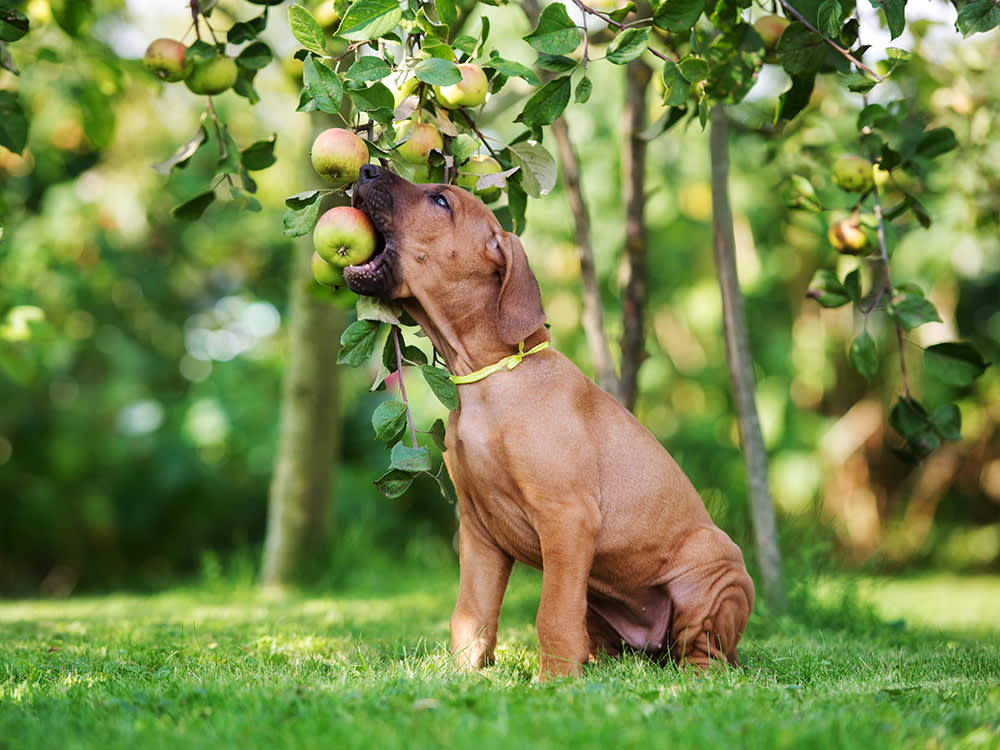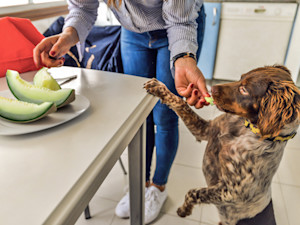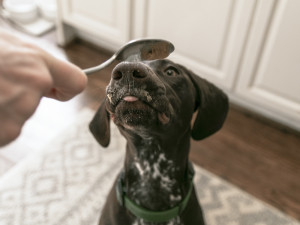Can Dogs Eat Apples?
Here’s why this fiber-filled fruit is a healthy treat for your dog.
Turns out, the old saying “An apple a day keeps the doctor away” is true for your dog, too. Apples are safe for dogs to eat — and for many pups, this sweet, crispy fruit is a favorite treat. That’s a good thing since apples are packed with essential vitamins and minerals, including vitamins A, C, and K, as well as calcium and phosphorus.
Many dogs seem to prefer the sweeter varieties — red or golden apples such as ggala, honeycrisp, and Fuji — to the green or more tart types like Granny Smith or gravenstein. Keep reading to learn more about the health benefits of apples for dogs, plus how to add them to your pup’s diet.
Nutrition facts: Apples for dogs
Are apples good for dogs?
Apples have many health benefits for your pup:
They’re low in calories: A super-healthy treat, apples are both affordable and low in calories. They’re also low in protein and fat, which makes them especially good for senior dogs.
They’re good for your dog’s teeth: Apples contain malic acid, which aids in keeping your dog’s teeth clean and their breath fresh.
They reduce inflammation: Apples contain antioxidants, such as quercetin, which plays an important role in helping combat free-radical damage linked to chronic diseases; it also aids in inflammation reduction.
They aid digestion: Apples are a good source of fiber, which helps promote digestion and gastrointestinal health. A medium-sized apple (about 3 inches in diameter, and 6 ounces in weight) provides 4.37 grams of soluble and insoluble fiber. Pectin, the soluble fiber, helps the body absorb water and creates a kind of gel that slows down digestion and the absorption of sugar into the bloodstream (a benefit for dogs with diarrhea or diabetes). The insoluble fiber can help prevent constipation.
Can dogs eat apple cores and seeds?
It’s best to feed your dog apples in moderation. Eating too many can cause an upset stomach and diarrhea. So, if you have apple trees in your garden, make sure your dogs don’t try to pick them for themselves.
As with all fruit, make sure to wash your apples, but don’t peel them. The skin is the primary source of fiber and antioxidants. To avoid pesticide residue, choose organic apples.
Apples are safe for dogs as long as you remove the seeds and the core. The seeds contain small amounts of cyanide, and while digesting a few seeds will not be harmful, eating too many could be poisonous. Cores can be a choking risk for smaller dogs, so it’s best to remove them as well.
Are apples completely safe for dogs?
Apples are very versatile. As long as you remove the stem, core, and seeds, you can feed them to your dog in a variety of ways. Here are some easy ideas:
Cut in half or in quarters — dogs enjoy munching on larger slices and, most likely, will nibble and gnaw them.
Cut them into smaller, thinner slices, and freeze them for a refreshing, cold treat (this is great for warmer months).
Chop or grate and add them to your dog’s meal. When chopping, smaller is often better to avoid a choking hazard.
Chop and use to stuff a Kong.
Make applesauce or a puree (remember, no need to peel them). For a refreshing, cold treat, freeze the sauce or puree in an ice cube tray. (Feed to your dog when they’re outside to avoid a mess.)
Other foods that are safe for dogs
Bananas: Bananas are a healthy and delicious treat your pup.
Mango: As long as they can handle the extra sugar, mangos can be a healthy snack for dogs.
Blueberries: Blueberries are packed full of antioxidants and fiber, and so they make an excellent treat for your dog.
Other foods that are dangerous for dogs
Avocado: Avocados can cause mild tummy upset in dogs, including vomiting and diarrhea, and so should be avoided.
Grapes: Dogs should never eat grapes or raisins because even small amounts can be toxic to them.
Corn cobs: Though corn kernels are safe for dogs, corn cobs should be avoided because they can be a choking hazard.
The bottom line: Can dogs eat human food?
Certain foods, like apples, are safe for both humans and dogs to eat, though only in moderation. Like all treats, strawberries should be supplementary to a complete and balanced dog food diet.
FAQs (People also ask):
How many apples can a dog eat?
Though apples are safe and healthy for your dog to eat, moderation is key: eating too many apples can give your pup an upset stomach and diarrhea.
Can dogs eat apple seeds and cores?
Before giving your dog any apple, remove the seeds and core. Apple seeds contain small amounts of cyanide, which is toxic to dogs, and the core can be a choking hazard.
Are apples safe for dogs?
Yes, apples are safe for dogs to eat in moderation.








